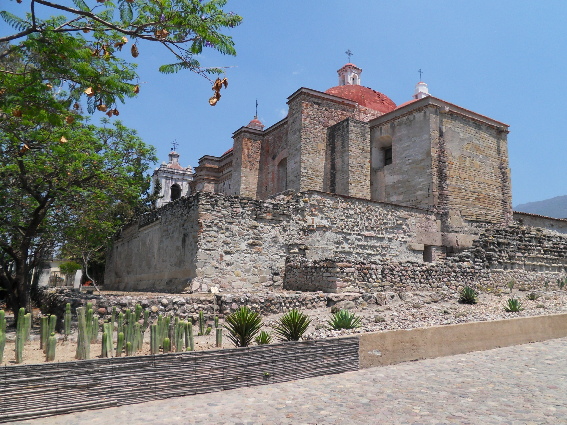The archaeological site of Mitla is located in the centre of the town which grew up around the ruins. Close by is the Church of San Paublo which was constructed by the Spanish in the 17th century using much of the material taken from site.
Mitla dates back to about 900 BC while the remains which are visible today date from about 200 AD to 900 AD when the Zapotecs controlled the area. In 1000 AD the Mixtecs took control of the site until 1200 AD when the Zapotecs regained it.
Mitla was the second most important ceremonial centre after Monte Alban. After the disappearance of Monte Alban it became the power centre for the entire valley. Originally known as Mictlan it was shortened by the Spanish to Mitla. Although in Zapotec language the site was called Lyoboa, which translated means “Resting Place”.
The site consists of five main groups of structures, the Southern Group and Clay Group, which have been classified as ceremonial centres. These are formed by the presence of mounds and central squares. The Creek Group, Columns Group and Church Group are classified as palaces, comprising of several chambers, set around square.
The Hall of Columns is 120 x 21 feet in size and has six monolithic columns of volcanic stone that originally supported a roof covering the entire hall. From this is a low, narrow passageway leading to the interior of another enclosure, which originally was covered by a roof. The walls of this chamber are covered with panels of inlaid cut-stone mosaic known as stepped-fret design, whose intricate geometric mosaics are believed to be a representation of the Sky Serpent and therefore a symbol of the Mesoamerican deity, Quetzalcoatl. The use of this chamber is not known although legend says the chamber was used for the final initiation of shamans who had been trained in magic and healing in the school of Mitla. In the Patio of Tombs, adjacent to the Hall of Columns, is a 2.8 meter tall column known as the "Pillar of Death" although this is also sometime referred to as the Pillar of Life.
The group of the columns contains two squares; the northern one, which contains the main building, is bordered by platforms on all four sides. The central patio contains the remains of an altar. It is here that the rectangular great Hall of Columns is found and a decorated patio, which provides access to four rooms. Each is decorated by three panels with ornate mosaics of carved stone of different geometric designs in each band. The panels contain thousands of polished stones, which are cut to fit without mortar.
The site contains a number of beautiful tombs which are located in the northern and eastern buildings; it was here that the Zapotec priests and kings were buried. The tombs are cruciform in plan and the rooms and antechambers are richly decorated with cut stone friezes. The walls are decorated with ornate mosaic panels.
Nearby to Mitla is the town of Santa Maria del Tule which contains the tree of Tule which is one of the oldest living things on earth. With a circumference of over 48 metres at its base, is between 2000 and 3000 years old.


To see more photographs and take a virtual tour of the site click on the photoshow below.
Addition information can be seen on Encyclopaedia Britannica
